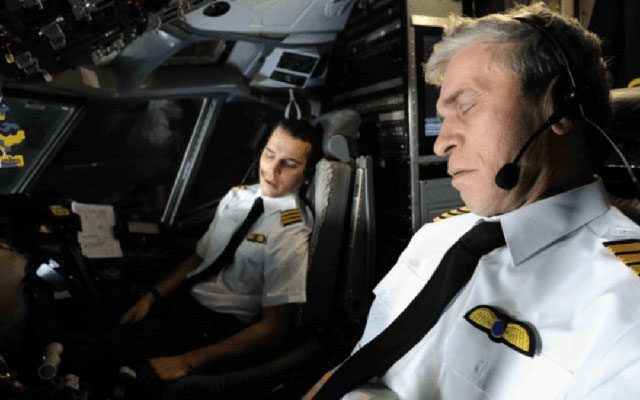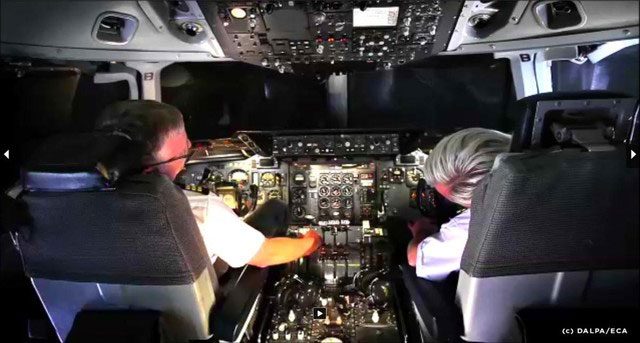Many people wonder if pilots can actually sleep on airplanes, especially during long flights. The answer is yes; they can indeed take short naps and rest while the aircraft is still flying high in the sky.
When boarding a plane and embarking on a long transoceanic journey, we often see pilots busy operating various instruments in the cockpit. Once the airplane is in stable flight, they seem to be able to sleep peacefully and sometimes even engage in casual conversations over the radio with the ground control. This leads to the question: Why can pilots sleep so soundly during flights?

On modern aircraft, pilots are provided with a designated rest area, commonly referred to as an “rest cabin.” This rest cabin is situated separately from the cockpit and is designed to ensure maximum tranquility and comfort for the pilots. It typically features bunk beds, curtains, electrical outlets, ventilation systems, and air conditioning. Pilots can take turns sleeping in this rest cabin in shifts, each lasting about 2-3 hours.
1. The Presence of Autopilot Systems
Modern passenger aircraft are equipped with advanced autopilot systems, which can automatically control the aircraft’s attitude and heading. The core components of the autopilot system include gyroscopes and accelerometers that can sense changes in the aircraft’s attitude and acceleration.
The autopilot system offers multiple operational modes, including altitude hold, course hold, and route tracking. Throughout the flight, pilots can select the appropriate mode as needed and allow the aircraft to fly automatically along a pre-defined route.
The presence of the autopilot system significantly reduces the workload for pilots, allowing them to rest during the flight. When the aircraft enters a stable phase, pilots often set the autopilot to maintain altitude or heading and then take a short break.

Many people worry that pilots sleeping on airplanes could affect flight safety. However, studies have shown that the alternating shifts of sleep for pilots do not affect their ability to control the aircraft.
2. Crew Coordination and Shift Changes
The flight crew typically consists of two pilots, one responsible for operating the cockpit and the other overseeing various parameters of the aircraft.
To ensure the health and energy of the pilots, airlines implement a strict flight rotation system. On long-haul flights, pilots are often assigned different periods of rest and work to ensure they have enough energy for critical moments.
Modern aircraft are equipped with advanced flight monitoring systems that can track various parameters of the aircraft in real-time and provide timely alerts in case of any issues. This allows pilots to rest fully in the cockpit without needing to remain constantly vigilant.

In practice, allowing pilots to sleep on the aircraft helps them maintain adequate health and mental clarity to ensure the safety of the flight. When well-rested, pilots are able to maintain high levels of concentration, quick reflexes, and make accurate decisions in complex situations.
3. Strict Safety Standards and Procedures
To become a qualified pilot requires rigorous training and certification. During their training, they learn various flying skills and knowledge, including how to respond to emergency situations.
Pilots must adhere to strict operational procedures and checklists when performing their duties. These procedures and checklists encompass all aspects of the flight to ensure safety and smooth operation.
Pilots receive real-time support from ground control and air traffic controllers throughout their flights. In case of issues, they can quickly contact relevant personnel and receive professional advice and guidance.
To ensure flight safety, airlines have strict regulations regarding pilots’ sleep time. These regulations often depend on flight duration, the number of pilots in the crew, and other factors.
For example, according to the regulations of the Federal Aviation Administration (FAA) in the United States, in a crew of two pilots, each pilot must have at least 10 hours of rest within a 24-hour period. Of that, the minimum sleep time on the aircraft is 5 hours.

Sleep plays a crucial role in the health and mental state of individuals. Lack of sleep can lead to serious consequences such as decreased focus, slower reflexes, increased risk of mistakes, and even hallucinations. For pilots, these effects can have catastrophic consequences, affecting the safety of both the crew and passengers. Therefore, ensuring that pilots have adequate rest and sufficient sleep is extremely important. According to the regulations of international aviation organizations, pilots are permitted to sleep in shifts throughout long flights.




















































